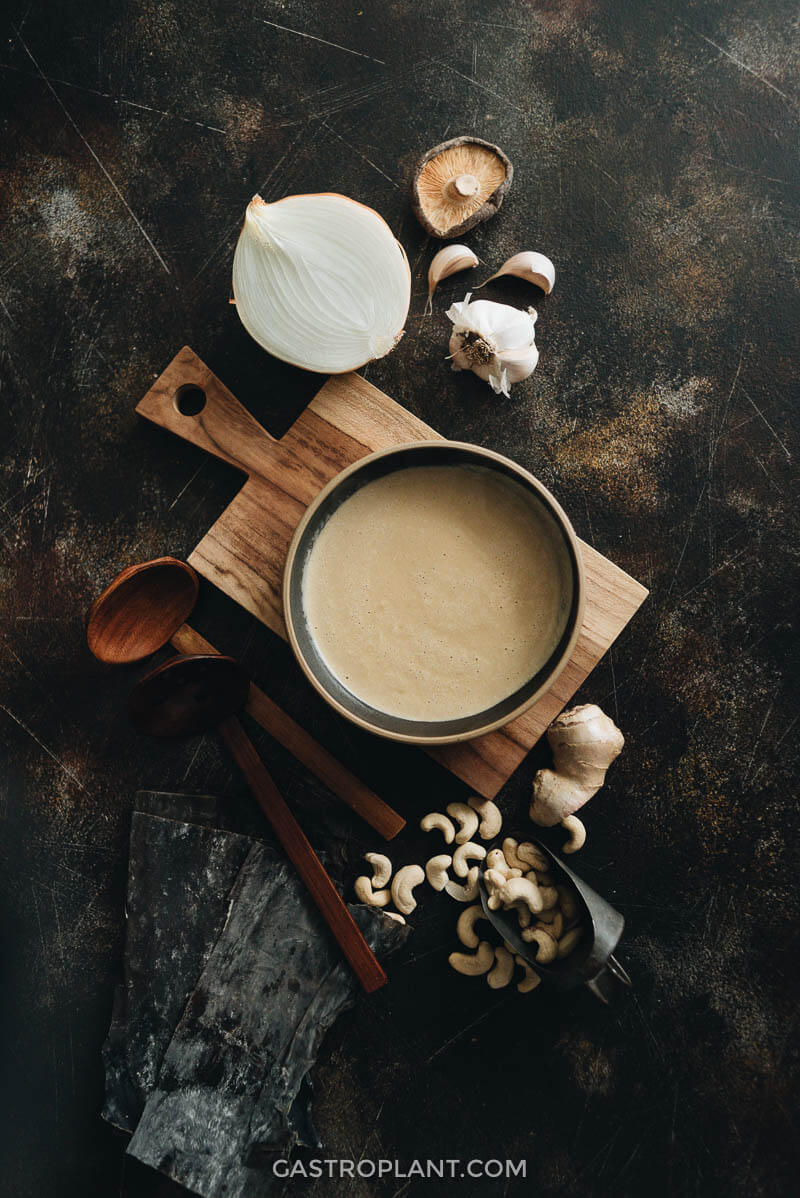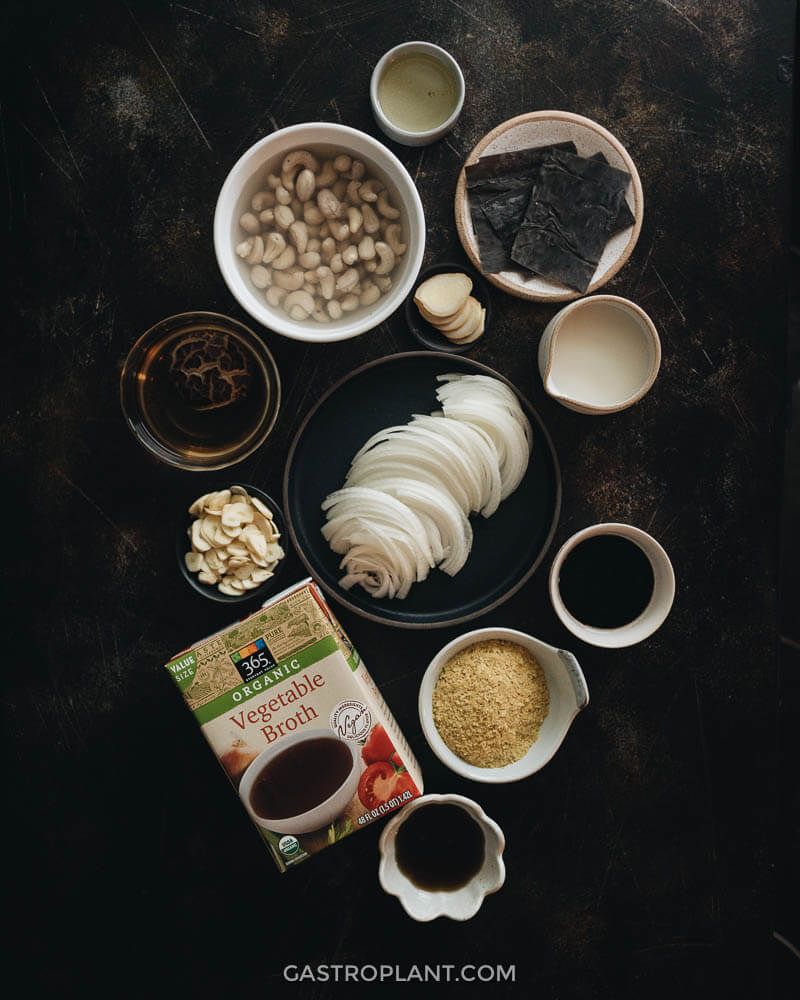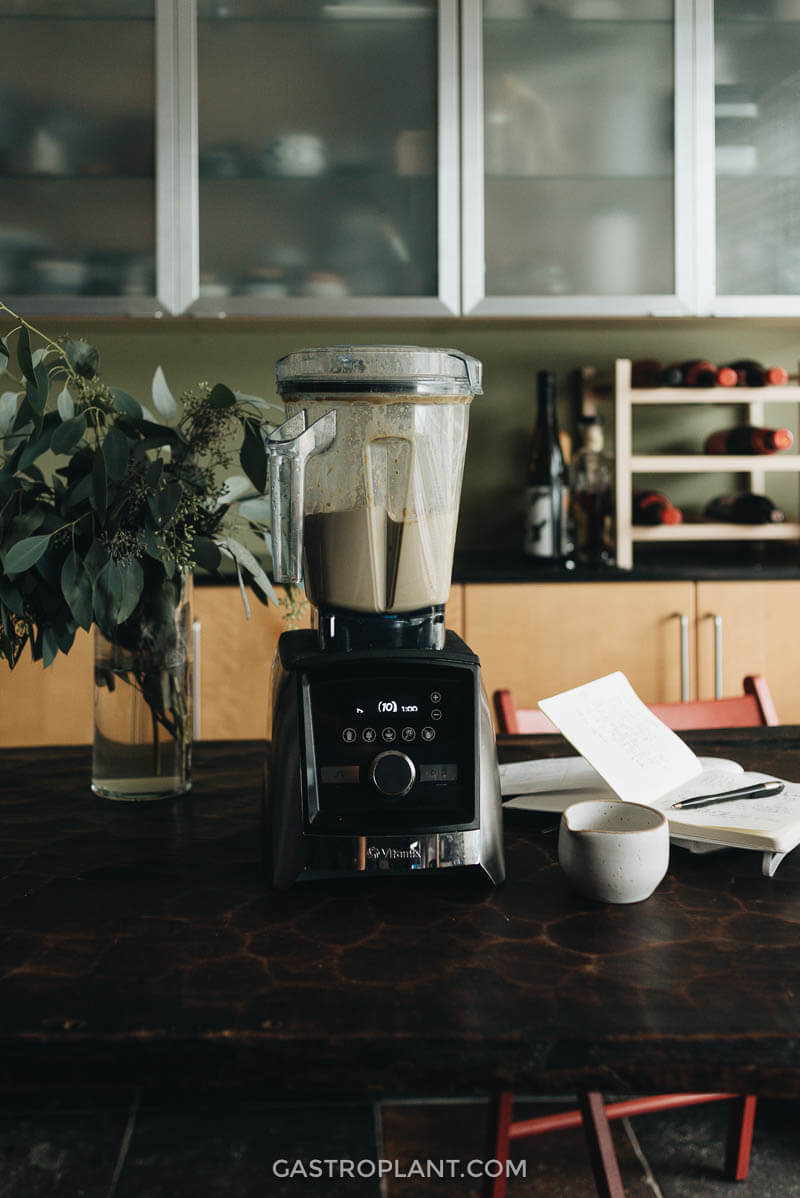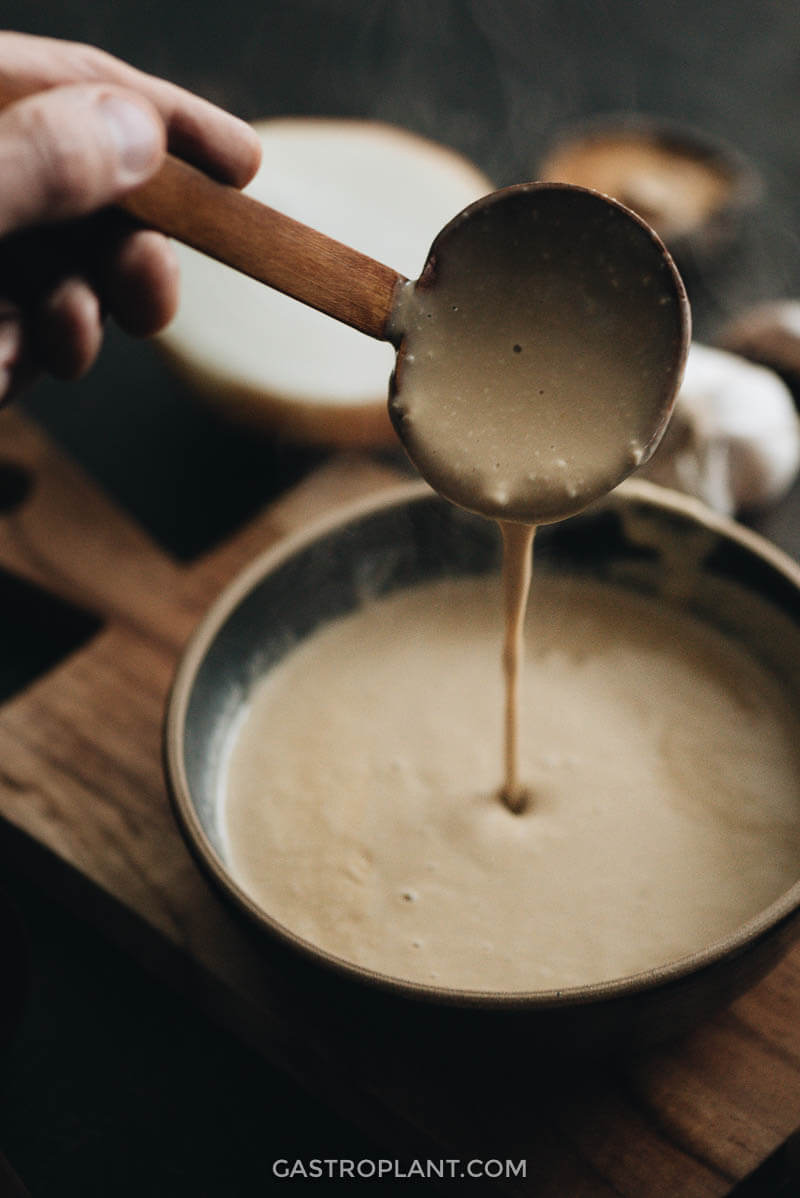This vegan tonkotsu ramen broth is as rich as any soup you’ve ever tasted. It’s intensely creamy, savory, and nutty. It clings closely to noodles, making your slurps most satisfying. A steaming hot pot of this goodness can be yours in just 30 minutes.

The origin of this vegan ramen broth
One chilly fall evening I was whipping up a pot of a staple of ours – kimchi stew. I’ve cooked it so many times that it’s basically second nature. For some reason though, I was curious how it would turn out with an added layer of creaminess. I pulled out the blender and made a savory cashew cream to add in. I poured in some toasted sesame oil because of the great flavor affinity between kimchi and sesame.
The stew turned out great – the nuttiness of the cream layered well with the sour spiciness of the kimchi. But there was something about it – it reminded us of something familiar. What could it be? Oh, right! Tonkotsu ramen! The notoriously laborious, rich, creamy, and complex pork bone ramen broth. The kimchi stew I made that night was pretty haphazard – it included whatever veggies happened to be in the fridge. Tasty, but not exactly an elegant dish.
From there, I worked to develop this into a simplified, yet still flavorful and complex plant-based tonkotsu broth. After a few days of tweaking, I settled on this recipe. It includes a vegetable broth boosted with caramelized onions, garlic, ginger, and kombu and the nutty sesame cream. Combining a clear broth with the thick cream creates a soup that is thin enough to drink, yet rich enough to coat noodles and other ingredients.


Why make this Vegan Tonkotsu Ramen Broth recipe?
For one, it’s just delicious. My wife Maggie, who lived in Japan a couple years and has eaten her share of ramen, couldn’t get enough of it. She’s been nudging me to write this post since I cooked the dish a month ago. We ate variations of this ramen 10 times in a week and didn’t get bored with it.
Two, it’s pretty healthy compared to the alternatives. Ramen at restaurants, plant-based or not, is almost always extremely salty. This one is pretty light on the salt. And while cashew are calorie-dense as far as plants go, this broth will be infinitely kinder to your body than a bowl of the original broth would be.
Three, it’s not that hard to make. Restaurants that specialize in ramen may take multiple days to create a batch of broth. This is not one of those recipes. It takes 10 minutes of prep and 30 minutes of cooking. Boil some noodles on the side and add some toppings, and you’re good to go.

Cooking notes
You can make this broth spicy by adding gochujang.
You can always thin the broth out with more vegetable stock if the consistency is too thick for your liking.
To see my post on the rest of the ramen ensemble, including the noodles and toppings, click here.
Other delicious plant-based Japanese recipes
- Yaki Udon – thick and toothy noodles, stir-fried with veggies, mushrooms, and tofu in a savory sauce. It’s as much about texture as flavor and is just fun to eat.
- Hijiki Salad – a salad of hijiki seaweed, carrot, tofu, edamame, and avocado. It is loaded with nutrition and can be served warm or cold.
- Curry Rice – a satisfying and comforting staple dish, this curry is mild and well-rounded and goes well with practically any savory food.
- Japanese Buddha Bowl Meal Prep – a diverse and nourishing array of foods you can prepare in advance. Includes roasted sweet potatoes, mixed rice, seaweed salad, and a tangy sesame dressing.
If you try this recipe out, let me know! Leave a comment, rate it (once you’ve tried it), and take a picture and tag it @gastroplant on Instagram! I’d love to see what you come up with.
Vegan Tonkotsu Ramen Broth
Ingredients
- 240 g onion diced (about 1/2 pound or half a medium onion)
- 25 g garlic minced (about half a bulb or 8 cloves)
- 10 g fresh ginger peeled and minced (about 2 Tbsp)
- 3 Tbsp peanut oil or other cooking oil
- 8 g dried kombu (about a 5-inch / 12-cm square)
- 2 liters vegetable stock (2 quarts)
- 1 cup raw cashews
- 1 dried shiitake mushroom
- 1 cup almond milk or other plant milk, unflavored and unsweetened
- 3 Tbsp toasted sesame oil
- 3 Tbsp Japanese soy sauce
- 1/2 cup nutritional yeast
Instructions
- Place shiitake mushroom in a cup of hot (though not boiling) water to rehydrate.
- Place cashews in a cup of hot (though not boiling) water to rehydrate.
- Heat peanut oil in a large, heavy pot over medium-high heat. When oil is hot, add onion. Cook until onions are medium brown, though not burned, 3-5 minutes, stirring very occasionally.
- Add garlic and ginger. Cook and stir for 2 minutes.
- Add vegetable stock and kombu. When broth begins to boil, reduce to medium-low heat.
- Simmer for 20 minutes.
- While the broth simmers, prepare the cashew cream mixture.
- Remove shiitake mushroom and cashews from the water, reserving the soaking liquid for use later.
- Combine nutritional yeast, sesame oil, soy sauce, soaked and drained mushroom, soaked and drained cashews, and almond milk in a high-speed blender. Blend for 20 seconds on low. Add some of the soaking liquid from the mushroom or cashews if the consistency is too thick to blend. The mixture should be quite thick, but mostly uniform at this point.
- Blend 20 seconds on medium, then 20 seconds on high.
- When the broth is finished simmering, strain out the onions, garlic, ginger, and kombu.
- Remove pot from heat. Stir in blended cashew cream mixture. Add water if consistency is too thick. Soup should be just thick enough to coat a spoon.
- Taste some soup. Add salt as needed.



Hi, this looks very tasty. Couple questions:
1. Can you recommend a substitution for the nutritional yeast (it doesn’t have to be vegan). Would soy sauce work?
2. Can this be frozen?
Thank you!
Hi Angela, thanks for your message. You ask an interesting question. Nutritional yeast is a pretty special ingredient so it’s hard to recommend a single replacement. It adds both flavor (nutty, umami, cheesy) and texture (thickness and creaminess).
I haven’t tried to substitute anything for it, but if you’re open to experimenting there are some things you can try. Saltine crackers, broken into small pieces, have a hint of the nuttiness and some of the texture. Parmesan cheese has a lot of umami – a small amount of it, ground could get you closer. And if you have access to vegemite or marmite, very small amounts of those could help replace the nutritional yeast. Both of those products are made from yeast and have some intense concentration of the flavor.
So, if you’re in an experimenting mood, try 1/4 cup crushed saltine crackers and either a tablespoon of shredded/grated parmesan or a quarter teaspoon of marmite or vegemite. Blend it as per the instructions and add more of the ingredient you think it could use more of – if it’s not thick enough, add more crackers, if the flavor isn’t as rich as you want it, add more parm or marmite/vegemite. You can also add soy sauce in the same way. The key is to add ingredients little by little, so you can build up to the flavor you like.
If you do have the chance to get nutritional yeast, I’d recommend giving it a try. It’s really versatile and makes many things tastier without sodium.
As for freezing, I haven’t tried it (we can’t seem to have leftovers long enough), but it should be fine. If it separates, there are a few tricks you can use to re-combine the broth. My favorite is to just whisk an ice cube into the broth once it has been heated on the stove.
I apologize for the long response but I hope this is helpful. Let me know how it goes. 🙂
I’m looking forward to making this! For about 12 years now I’ve been dabbling in the vegan -> plant-based lifestyle. Until today, I thought I had seen the entire gamut of responses to recipe adjustments. Some authors take offense or refuse to respond. Others may offer routine replacements such as sunflower seeds for cashews or lemon juice for lactic acid.
But! The thorough response above has clearly raised the bar. It’s both thoughtful and novel. Saltine crackers + parmesan cheese + vegemite/marmite as a substitute for nutritional yeast. Wait, what? I was assembling the slight thickening properties and flavors in my head while reading and thinking “wow, he might be onto something there”. So much so, that I am probably going to give that a try in a recipe or two that lean on the accented traits of nutritional yeast just to see how they turn out. That, plus my better nine-tenths is averse to nooch.
Thank you for sharing your recipes, and thank you again for your uniqueness and added insight.
Hi Craig! Thanks for the kind words and I’m happy you found that this impromptu brainstorming session helpful 🙂 I love the experience of eating vegan food but it’s also fun to look at it analytically, teasing out the flavor and texture elements that make the food enjoyable to begin with.
I’d just advise starting small with the vegemite/marmite, since the bitter edge might interfere with the other flavors.
Now that I’m thinking about it, ground, freshly toasted sesame seeds can also impart some of the nuttiness of nooch. You might look at that as another potential piece of the equation, whether for this dish or any other.
In any case, let me know how it goes and if you have questions. Happy cooking!
If it is a case of not being able to get yeast extract and you aren’t allergic then Marmite/Vegemite could work although I wouldn’t know what quantities to use but no more than a teaspoon or two I would think.
This was delicious! Very creamy/nutty/umami satisfying. Question though: when and where did you add your milk?
Hi, Umame. Thanks for your message and I’m very happy to hear that it was tasty. I apologize for the omission in the recipe. I add the milk to the blender when blending the cashews and nutritional yeast. I’ve updated the recipe to show this.
Made this tonight and it was stunning. Perfect texture and flavor. I added some white miso and a splash of mirin to the broth, and added a few teaspoons of soy sauce, rice vinegar and sesame oil used to marinade some tofu. Served it over ramen noodles with assorted toppings – marinaded fried tofu, roasted yams and brussels sprouts, fried scallions with scallion oil and fresh scallions and cilantro. 10/10, this is a keeper. Thanks for the recipe!
Also, highly recommend drizzling some white truffle oil on top just before serving.
That sounds like an awesome combination, Conor. I love the toppings and garnishes you chose. I can see the miso and mirin making the broth really pop. And the truffle oil is just next-level. Anyway, I’m glad I could be of help! 🙂
Hi Thomas,
12 servings is a lot and while I know I could just make less, I do like the idea of having this broth ready to eat whenever I want… Any idea if it freezes well? Thanks!
Hi, Patricia. I haven’t tried freezing it, but everything I’ve read about freezing cashew cream suggests it should be no problem. The only potential issue is separation, which is easily fixed by whisking an ice cube into it once the broth has been reheated. Good luck and let me know how it goes! 🙂
Bah I just noticed you already answered that question before. Sorry! Anyway, I’ll let you know. 🙂
Hi there, I’m not sure where to look for Kombu is there an alternative? Would Nori or dulse powder work or is that the wrong flavour?
Hi Sammy, you should be able to find Kombu at an Asian (Japanese, Korean, Chinese) grocery store. The kombu is special because it lends its flavor to the broth in a subtle way and doesn’t dissolve into the broth. It’s actually not too different from nori or dulse in flavor – they all taste mildly like the sea. The difference with nori and dulse is that there will be a million tiny flakes, which changes the appearance of the soup. You can either strain them out or leave them in (if you don’t mind the look). I’d try 2 sushi-sized (about 20×20 cm) pieces of nori or 2 tablespoons of dulse. Dried wakame can also be quite nice – similar flavor profile, doesn’t break apart, and is edible with a nice texture. I’d add 1 tablespoon of dried wakame. Hope this is helpful and let me know how it goes!
One other thing – you could skip the seaweed altogether and the soup will still be pretty good!
Is oil an important ingredient? I tend to have trouble digesting oil so try to limit my intake.
I think you can still make a pretty tasty soup if you’re OK digesting the richness of the blended cashews (and possibly blended sesame seeds). The peanut oil just gives us a way to saute the onion, ginger, and garlic to develop those flavors. And the sesame oil gives nuttiness. I would try replacing the peanut oil with vegetable stock or water. You might want to increase the amounts of onion, ginger, and garlic slightly, since the flavor development won’t be as strong. And the ingredients may not get browned. And then, to replace the sesame oil, you can either use Japanese sesame paste, Chinese sesame paste, or tahini (in that order of preference). Blending toasted sesame seeds should also work. I hope this helps, and please let me know if you have any other questions! 🙂
I tried it with Chinese sesame paste and no peanut oil – still fantastic! Really rich flavor.
Glad to hear it was tasty! Chinese sesame paste has such a great nuttiness. I’d like to add a note to the recipe – do you remember how much of the paste you used? And was peanut oil the only ingredient you replaced?
I believe I used 3 tbsp of sesame paste since the recipe called for 3 tbsp of oil. Maybe could have cut it down, but I enjoyed the nutty flavor.
Hope this helps!
Yes, it does help! Thanks for letting me know. 🙂
I love it! I was looking specifically for vegan tonkotsu recipe and found your page. It is insanely good and requires such a small amount of effort. Thank you for sharing! I will for sure be trying more of your recipes! Cheers from Poland 🙂
I’m happy you enjoyed it! 🙂
I tried this recipe yesterday night for my partner’s birthday! He was amazed, and I have to say that was one of the best Ramen I have ever had. Thank you so much Thomas!
I remember being once in Japanese restaurant in Brussels serving thick rich vegan ramen and I couldn’t find it anywhere else. And that recipe just fulfilled my craving. Super delicious and not complicated dish. Thank you once again! 🙂 Im gonna try your other recipes and I am saving your super blog to my favourites.
Can I use coconut milk instead of almond? Will the taste be very different?
Do you literally mean one single dried mushroom or is that mushroom as a plural as you often find in translated Asian recipes?
It may sound strange, but it’s just one mushroom. Shiitake mushrooms are really potent to begin with, and this one gets blended into the broth. So one is all you really need. 🙂
Just made this recipe, along with some suggestions from the comments. It was amazing! Thanks for sharing the recipe.
Thanks Teng! I am happy that you enjoyed it.
I’m loving this recipe!
Was wondering…can the broth be frozen to use for later?
Hi Mae – it can be frozen! If it does separate upon reheating, whisking in an ice cube should help it recombine.
Hi, made this for a vegan friend and we both loved it! I will be making this instead of regular tonkotsu, it’s much lighter and quicker! Thank you so much!
Hi! I’ve made this recipe a few times now and it’s one of my faves, and my partner’s favourite as well! He always requests this on a chilly Friday night in. We love the taste of this broth – it’s creamy, rich, and so full of flavour. Hope to one day make this for our future kids to enjoy as well! Thank you so much for sharing!
Awesome, thank you for the feedback! It gives me a great feeling to know that you’ve enjoyed it several times now.
Hi Thomas,
This recipe looks amazing, but unfortunately I’m allergic to cashews (I know, big problem for a vegan!) Do you have any suggestions for substitutions?
Thank you!
Hi Elijah, I think you can make a really tasty version of this broth if you use sesame paste instead of cashews – e.g. tahini or zhimajiang. I haven’t tried Japanese white sesame paste but I think it should work well, too. I’d start with 1/3 the amount of cashews, in terms of volume, and then blend in more until it’s creamy enough. It should be thick enough to coat a spoon OK but still slurpable!
One more thing – if you use sesame paste, you won’t need nearly so much (or maybe any) toasted sesame oil. Taste the broth without the oil and if you like the nuttiness level, you don’t need to add any.
This is the best Vegan ramen broth! Delicious. This is my go-to ramen broth – I have made it so many times!. I usually Freeze half of the broth (up to step five) to use later and then make only half the cashew cream. When I take out the frozen broth then I make a half recipe of the cashew cream to go in it on that day. I am not sure it would freeze well with the cashew cream mixed in. Everyone in my family loves this!
I made the soup yesterday and I wanted to say how absolutely delicious and flavorful it is. I have been looking for a tasty vegan broth for Ramen noodles and this is the one. Thank you!